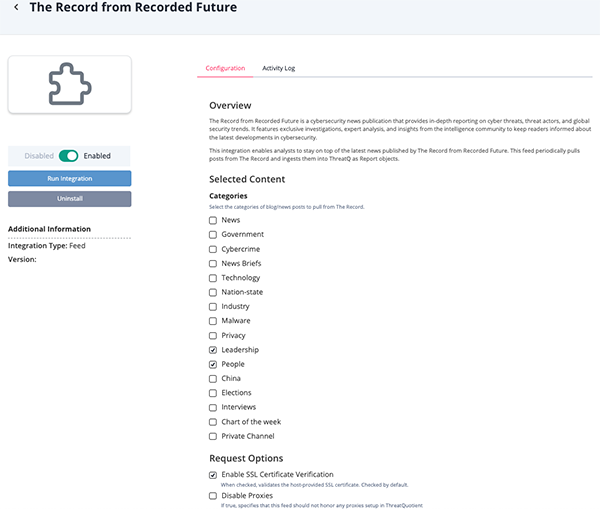The Record from Recorded Future News CDF
The web format of this guide reflects the most current release. Guides for older iterations are available in PDF format.
Integration Details
ThreatQuotient provides the following details for this integration:
| Current Integration Version | 1.0.0 |
| Compatible with ThreatQ Versions | >= 5.5.0 |
| Support Tier | ThreatQ Supported |
Introduction
The The Record from Recorded Future News CDF integration enables analysts to stay on top of the latest news from the Record from Recorded Future News, a cybersecurity news publication that provides in-depth reporting on cyber threats, threat actors, and global security trends. The site features exclusive investigations, expert analysis, and insights from the intelligence community to keep readers informed about the latest developments in cybersecurity.
The integration provides the following feed:
- The Record from Recorded Future - ingest news posts from The Record News's security category as reports.
The integration ingests Reports and Report attributes.
Installation
Perform the following steps to install the integration:
The same steps can be used to upgrade the integration to a new version.
- Log into https://marketplace.threatq.com/.
- Locate and download the integration yaml file.
- Navigate to the integrations management page on your ThreatQ instance.
- Click on the Add New Integration button.
- Upload the integration yaml file using one of the following methods:
- Drag and drop the file into the dialog box
- Select Click to Browse to locate the file on your local machine
ThreatQ will inform you if the feed already exists on the platform and will require user confirmation before proceeding. ThreatQ will also inform you if the new version of the feed contains changes to the user configuration. The new user configurations will overwrite the existing ones for the feed and will require user confirmation before proceeding.
The feed will be added to the integrations page. You will still need to configure and then enable the feed.
Configuration
ThreatQuotient does not issue API keys for third-party vendors. Contact the specific vendor to obtain API keys and other integration-related credentials.
To configure the integration:
- Navigate to your integrations management page in ThreatQ.
- Select the OSINT option from the Category dropdown (optional).
If you are installing the integration for the first time, it will be located under the Disabled tab.
- Click on the integration entry to open its details page.
- Enter the following parameters under the Configuration tab:
Parameter Description Categories Select the categories of blog/news posts to pull from The Record. Options include: - News
- Government
- Cybercrime (default)
- News Briefs
- Technology
- Nation-state
- Industry
- Malware (default)
- Privacy
- Leadership
- People
- China
- Elections
- Interviews
- Chart of the week
- Private Channel
Enable SSL Certificate Verification Enable this parameter if the feed should validate the host-provided SSL certificate. Disable Proxies Enable this parameter if the feed should not honor proxies set in the ThreatQ UI.

- Review any additional settings, make any changes if needed, and click on Save.
- Click on the toggle switch, located above the Additional Information section, to enable it.
ThreatQ Mapping
The Record from Recorded Future
The The Record from Recorded Future feed periodically pulls news posts from The Record News' security category and ingests them into ThreatQ as Report objects.
GET https://cms.therecord.media/api/articles
This request returns JSON data, which is parsed for tags, editors, categories, and the link to the underlying article. The full article content is then fetched.
GET https://therecord.media/{{ uri }}
The mapping for this feed is based on the .data[] array in the JSON data, as well as information parsed out of the article's HTML content:
| Feed Data Path | ThreatQ Entity | ThreatQ Object Type or Attribute Key | Published Date | Examples | Notes |
|---|---|---|---|---|---|
.title |
Report.Title | N/A | .publishedAt |
Phishing campaign impersonating Booking.com targets hospitality sector with malware |
N/A |
| N/A | Report.Description | N/A | N/A | N/A | Parsed from the HTML |
.publishedAt |
Report.Attribute | Published At | N/A | April 05, 2025 |
N/A |
.editor.data[].attributes.name |
Report.Attribute | Editor | N/A | Alexander Martin |
N/A |
.tags.data[].attributes.name |
Report.Tag | N/A | N/A | encryption |
N/A |
.categories.data[].attributes.name |
Report.Attribute | Category | N/A | Government |
N/A |
Average Feed Run
Object counts and Feed runtime are supplied as generalities only - objects returned by a provider can differ based on credential configurations and Feed runtime may vary based on system resources and load.
| Metric | Result |
|---|---|
| Run Time | 1 minute |
| Reports | 4 |
| Report Attributes | 12 |
Known Issues / Limitations
- The feed utilizes since and until dates to make sure entries are not re-ingested if they haven't been updated.
- If you need to ingest historical blog posts, run the feed manually by setting the since date back.
- The categories returned by the API are occasionally different from the categories displayed on the website. This can result in less articles ingested into ThreatQ as compared to the website.
Change Log
- Version 1.0.0
- Initial release
PDF Guides
| Document | ThreatQ Version |
|---|---|
| The Record from Recorded Future News CDF Guide v1.0.0 | 5.5.0 or Greater |